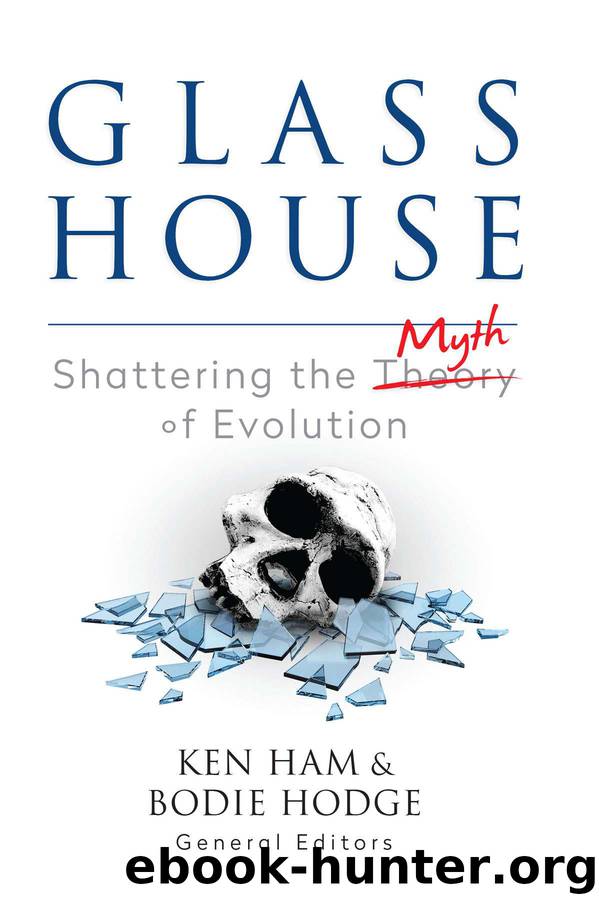Glass House by Ken Ham

Author:Ken Ham
Language: eng
Format: mobi, epub
Tags: REL106000, REL067030
ISBN: 9781614587026
Publisher: Master Books
Published: 2019-01-31T16:00:00+00:00
While any good biblical creationist would agree that natural selection (which is observable in the present) can and does lead to adaptation and variation within a kind (like the finches), it does not and cannot lead to the types of changes necessary for molecules-to-man evolution. In fact, time is irrelevant. What is needed for evolution to occur is genetic mechanisms, like mutations, that can provide the necessary complexity AND natural selection. But the combination of mutations (discussed in chapter 15) and natural selection is not capable of this.
Genetically speaking, we know that two genes are critical for variation in beak size and shape — BMP4 (bone morphogenetic protein)14 and calmodulin.15 Differences in the expression levels and expression locations of these genes lead to short, wide beaks and long, narrow beaks and beak types in between. Within any given finch species there is always some variety. In some years, the seeds available for food favor those finches with wide beaks and in other years it favors those with narrow beaks. Essentially, the beak size within the species oscillates but the beak stays a beak and the finch stays a finch! Again, time is irrelevant because all natural selection can do is select for or against genetic variety that is already present. It (along with mutations) can’t produce the variety needed for molecules-to-man evolution.
Over the last four decades, the process of species formation in Darwin’s finches has been observed.16 The resulting new species, called Big Bird, was a hybrid resulting from the mating of a medium ground finch with a large cactus finch. Big Birds have a unique beak size/shape and mating song, so only mate with other Big Birds. The hybrid finches are also larger and may be able to access food choices that other finches cannot, and appear to be surviving well on the island on which they first appeared. Hybridization is one way in which additional combinations can occur within a population and increase its survival. Future weather changes (e.g., El Niño) that affect the typical food source for finches on the island may not affect the food source of the Big Bird species, allowing natural selection to favor it under those conditions. But again, natural selection (along with mutations) simply tweaked the size and shape of the birds; it didn’t produce a dramatic increase in complexity.
Antibiotic Resistance in Bacteria
Antibiotic resistance in bacteria is another example of natural selection that is often portrayed as “evolution in action.” But, as we will see, natural selection works in conjunction with mutation to bring about variation within bacteria but does not lead bacteria to become a different kind of organism as evolution requires.
Antibiotics are natural products produced by fungi and bacteria, and the antibiotics we use today are typically derivatives of those. Because of this relationship, it is not surprising that some bacteria would have resistance to certain antibiotics; they must do so to be competitive in their environment. In fact, if you took a sample of soil from outside your home, you would likely find antibiotic-resistant bacteria.
Download
This site does not store any files on its server. We only index and link to content provided by other sites. Please contact the content providers to delete copyright contents if any and email us, we'll remove relevant links or contents immediately.
The Lost Art of Listening by Michael P. Nichols(7406)
Why I Am Not A Calvinist by Dr. Peter S. Ruckman(4100)
The Rosicrucians by Christopher McIntosh(3466)
Wicca: a guide for the solitary practitioner by Scott Cunningham(3127)
Signature in the Cell: DNA and the Evidence for Intelligent Design by Stephen C. Meyer(3071)
Real Sex by Lauren F. Winner(2967)
The Holy Spirit by Billy Graham(2892)
To Light a Sacred Flame by Silver RavenWolf(2768)
The End of Faith by Sam Harris(2690)
The Gnostic Gospels by Pagels Elaine(2472)
Waking Up by Sam Harris(2391)
Nine Parts of Desire by Geraldine Brooks(2325)
Jesus by Paul Johnson(2310)
Devil, The by Almond Philip C(2281)
The God delusion by Richard Dawkins(2265)
Heavens on Earth by Michael Shermer(2237)
Kundalini by Gopi Krishna(2137)
Chosen by God by R. C. Sproul(2122)
The Nature of Consciousness by Rupert Spira(2045)
